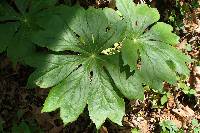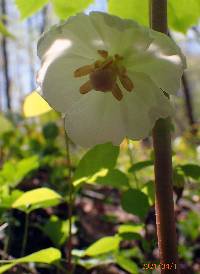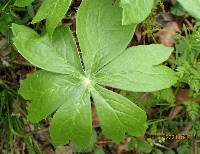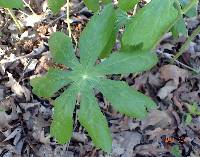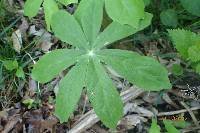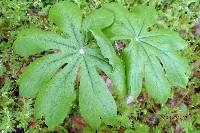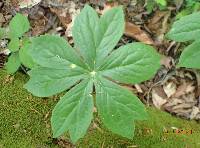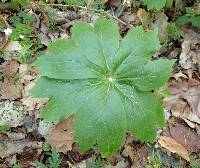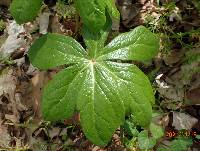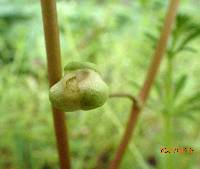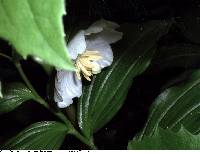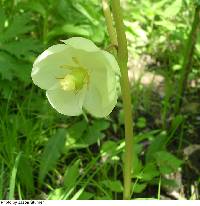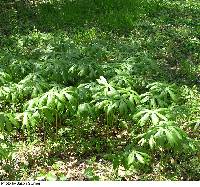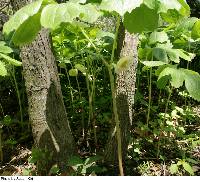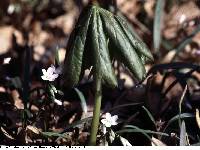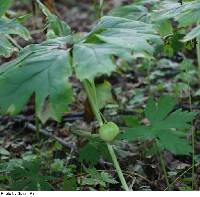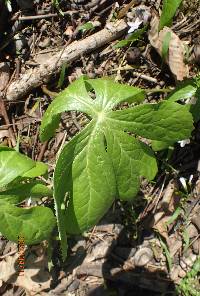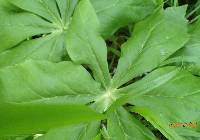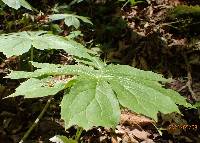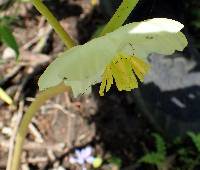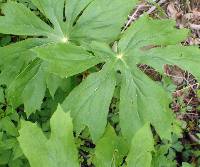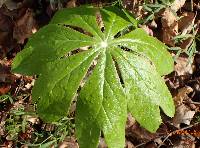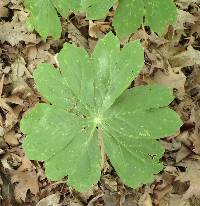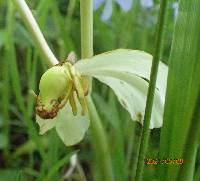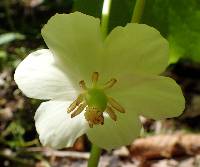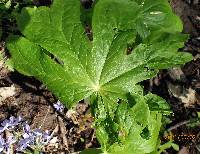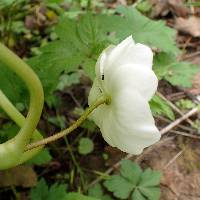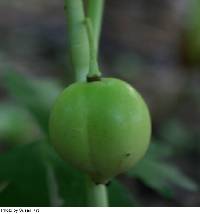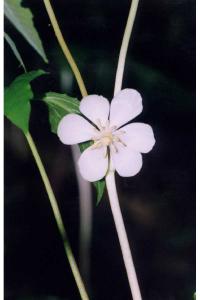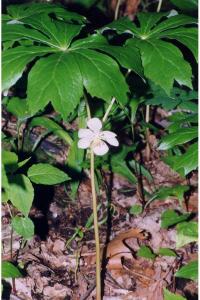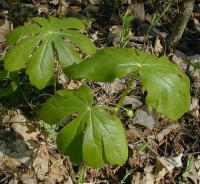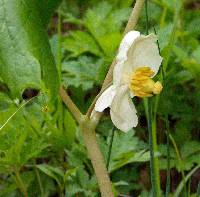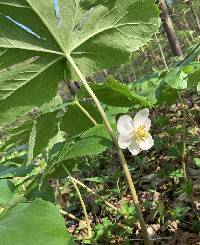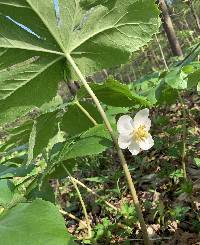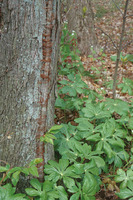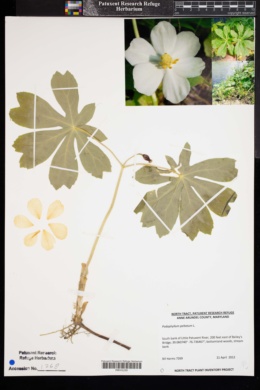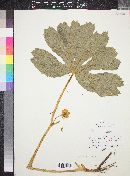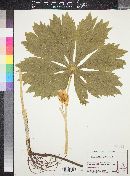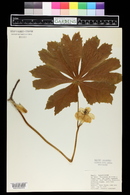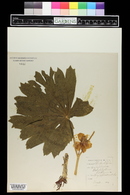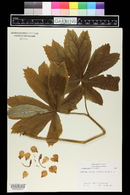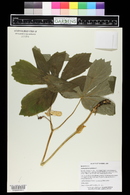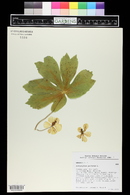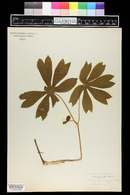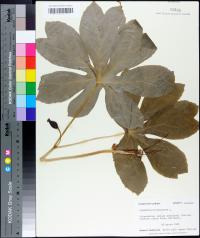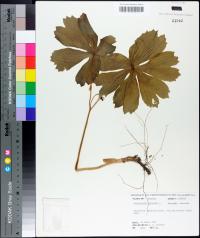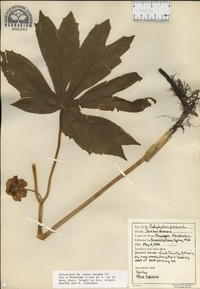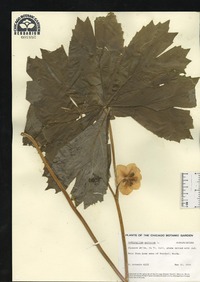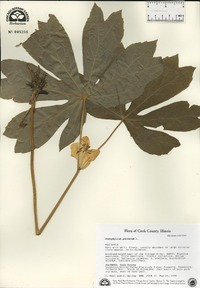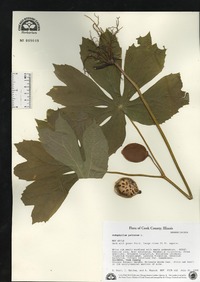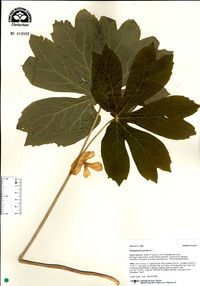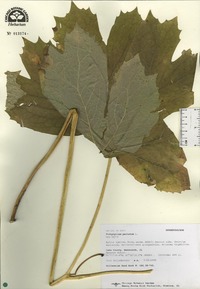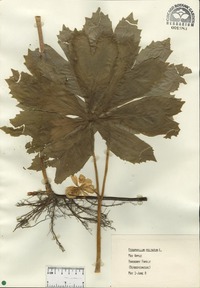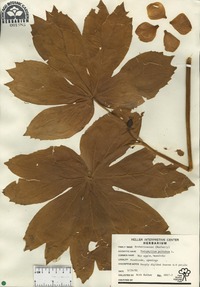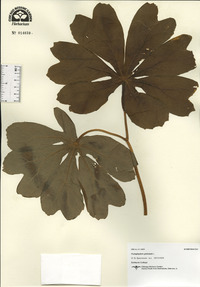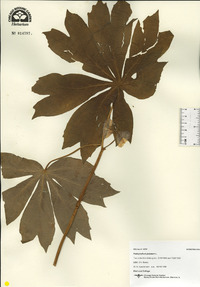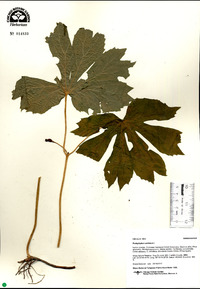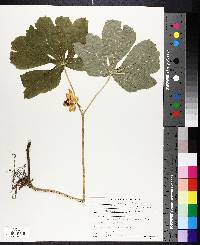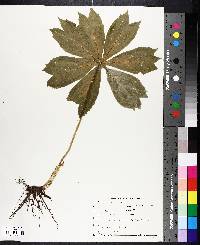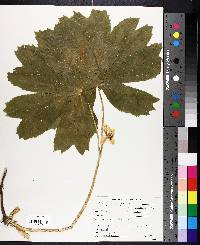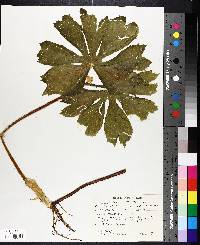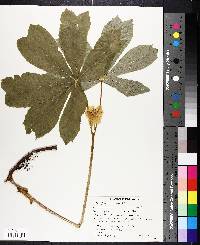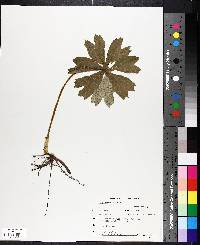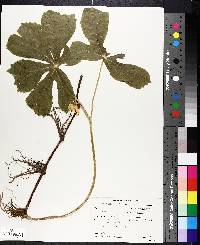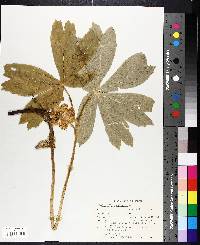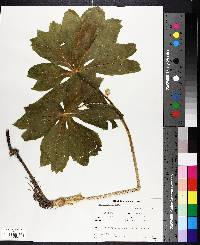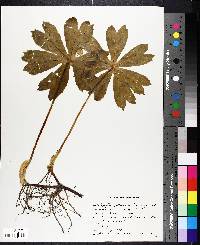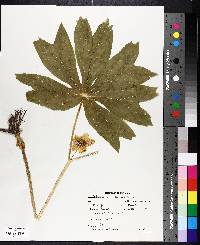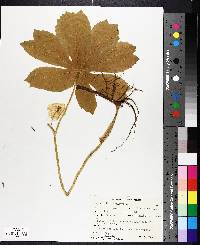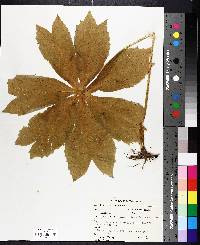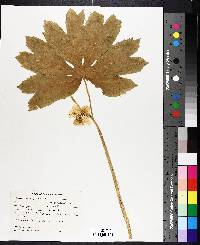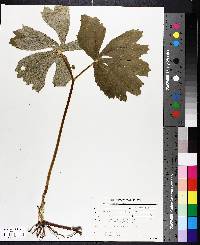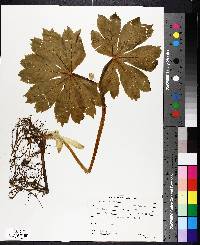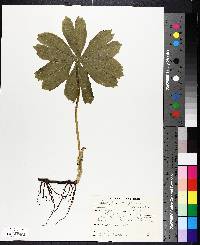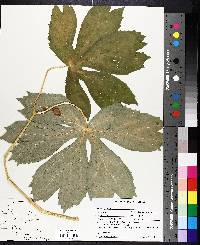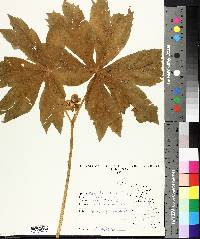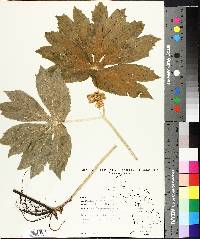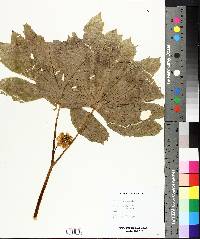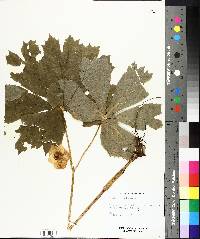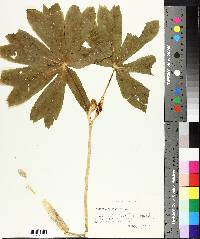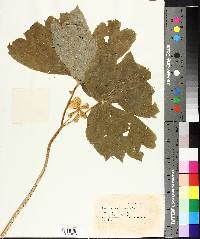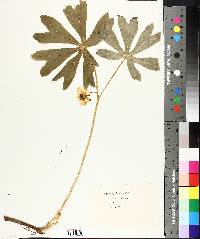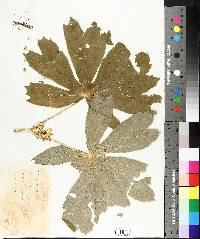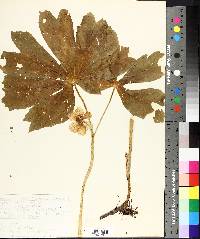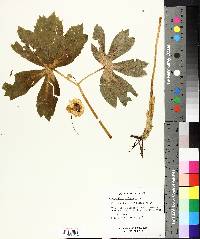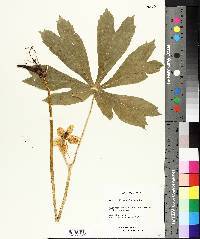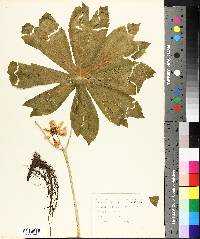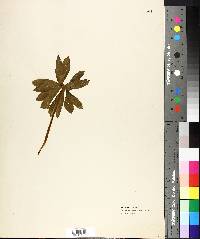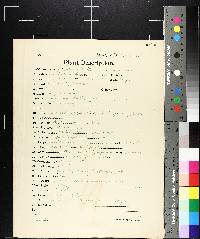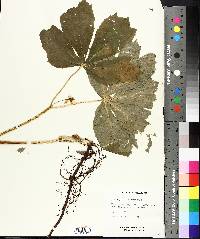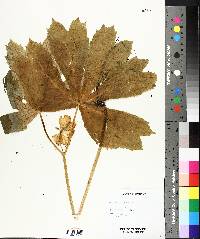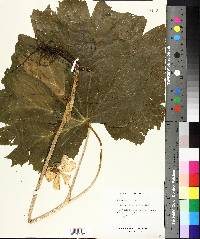
|
|
|
|
Family: Berberidaceae
May-Apple, more...wild-mandrake, mayapple
[Podophyllum peltatum f. deamii Raymond] |
Rhizomes: annual elongation increments (2-)6-20 cm. Leaves of nonflowering shoots 2-5 dm; blade 18-38 × 18-38 cm. Flowering shoots 3-6 dm; leaves nearly opposite, slightly unequal in size; petioles 5-15 cm; proximal blades 10-35 × 14-40 cm, distal blades 6-25 × 10-33 cm. Leaf blades 5-7(-9)-parted, parts lobed or not (frequently 2-lobed), margins entire or coarsely dentate, teeth apiculate; surfaces abaxially sparsely pubescent to glabrous. Flowers solitary, nodding, fragrant; peduncle arising from angle between petioles, 1.5-6 cm; sepals orbiculate, 10-18 × 10-18 mm; petals white, rarely pink, obovate, 15-35 × 10-25 mm; stamens 2 times number of petals, 8-13 mm; filaments 3-5 mm; anthers 5-8 × 1-1.5 mm; ovaries 6-12 × 4-8 mm; style 1-2 mm; stigmas 3-6 mm. Berries yellow, rarely orange or maroon, 3.5-5.5 × 2.0-4 cm. Seeds 30-50, ovoid, 6-8 × 4-6 mm. 2 n = 12. Flowering spring, fruiting late spring-summer; summer deciduous. Mixed deciduous forest, fields, moist road banks, river banks; 50-800 m; Ont., Que.; Ala., Ark., Conn., Del., D.C., Fla., Ga., Ill., Ind., Iowa, Kans., Ky., La., Md., Mass., Mich., Minn., Miss., Mo., Nebr., N.H., N.J., N.Y., N.C., Ohio, Okla., Pa., R.I., S.C., Tenn., Tex., Vt., Va., W.Va., Wis. The following forms have been described: Podophyllum peltatum forma aphyllum Plitt--fertile shoots with no foliage leaves; Podophyllum peltatum forma biltmoreanum Steyermark--fruits orange; Podophyllum peltatum forma deamii Raymond--fruits and seeds maroon, and flowers, placentae, and plant axes pink-tinged; Podophyllum peltatum forma polycarpum (Clute) Plitt--flowers with multiple, free carpels. The ripe fruit of Podophyllum peltatum is considered edible; all other parts of the plant are toxic. Several lignans and their glycosides, present in the resin extracted from rhizomes and roots, exhibit antitumor activity. Etoposide, a semisynthetic derivative of one of the lignans, is currently used in the treatment of small-cell lung cancer and testicular cancer (P. M. Dewick 1983). Native Americans used Podophyllum for a wide variety of medicinal purposes and as an insecticide (D. E. Moerman 1986). Podophyllum peltatum is sometimes cultivated in woodland gardens, and some populations on the periphery of its geographical range may be escapes from cultivation.
Perennial colony-forming herb 30 - 50 cm tall Stem: erect, unbranched, bearing either one or two leaves. The entire plant dies back to the ground in summer. Leaves: of non-flowering stems solitary, basal, with stout stalk attached to center of blade (peltate), the blade 18 - 38 cm across and more or less round. Flowering stems usually have two alternate to nearly opposite leaves, each with a stalk attached near the margin and a kidney-shaped to rounded blade reaching 6 - 35 cm long and 10 - 40 cm wide. Both types of leaves are three- to nine-parted, with each part often two-lobed, sometimes toothed, and hairless or slightly hairy underneath. Flowers: borne solitary on a nodding stalk between a pair of leaves, white to pale green (rarely pink), 3 - 5 cm across, with six sepals 1 - 1.8 cm long and six to nine petals 1.5 - 3.5 cm long, fragrant. Fruit: a yellow berry, 3 - 5.5 cm long, 2 - 4 cm wide, egg-shaped, containing 30 to 50 seeds. The seeds are 6 - 8 mm long, egg-shaped, enclosed by a yellow fleshy appendage (aril). Similar species: Caulophyllum thalictroides has compound leaves that are twice-divided into three branches, with each branch ending in three leaflets (triternate), flowers borne on an inflorescence, and naked blue seeds. Jeffersonia diphylla has leaves divided into two kidney-shaped segments, flowers borne solitary on a leafless stalk, and brownish capsule-like fruit. Flowering: early May to early June Habitat and ecology: Very common in woodlands, developing large, circular, vegetative colonies. This species is often able to survive habitat destruction, and has been seen growing in a bluish grass meadow that was once forest. Occurence in the Chicago region: native Notes: The leaves, roots and seeds of this plant are toxic. However, compounds extracted from the rhizomes and roots appear to have antitumor properties and have been used to create cancer-fighting drugs. Etymology: Podophyllum comes from the Greek words pous, meaning foot, and phyllon, meaning leaf, probably referring to the stout basal leafstalk of the non-flowering stems. Peltatum means shield-shaped, referring to the stalk's connection at the center of the leaf. Author: The Morton Arboretum Radical lvs scattered, with a stout, erect, stem-like petiole and peltate, deeply lobed blade to 3 or 4 dm wide; stem erect, 3-5 dm, with a pair of petiolate, half-round to cordate or unequally peltate, similarly lobed but mostly smaller lvs; peduncle nodding, short, fl white (pink), 3-5 cm, wide; fr yellow, 4-5 cm, the pulp edible when ripe; 2n=12. Seeds and herbage poisonous. Moist, preferably open woods; Que. to Minn., s. to Fla. and Tex. May. Gleason, Henry A. & Cronquist, Arthur J. 1991. Manual of vascular plants of northeastern United States and adjacent Canada. lxxv + 910 pp. ©The New York Botanical Garden. All rights reserved. Used by permission. From Flora of Indiana (1940) by Charles C. Deam Infrequent to common throughout the state in moist woods. It often spreads and persists after woodlands are cleared because of its creeping rootstLocks and the fact that no grazing animal will eat it. The rhizomes are cathartic and have long been much used in medicine. The mature fruit is short-elliptic or suborbicular, light yellow, rarely 5.5 cm long and not poisonous, as some people think. I am very fond of them and have eaten them in quantity to determine whether any ill effect resulted from eating them. In 1927 I found a specimen that had a maroon colored fruit in a woods on the Arthur Miller farm near Mauckport, Harrison County. I did not preserve the fruit but I moved the plant to our garden where it multiplied and in 1937 I succeeded in maturing four large fruits. These I sent to Dr. Edgar Anderson, of the Missouri Botanical Garden, for study. …… Indiana Coefficient of Conservatism: C = 3 Wetland Indicator Status: FACU |
|
|
|


